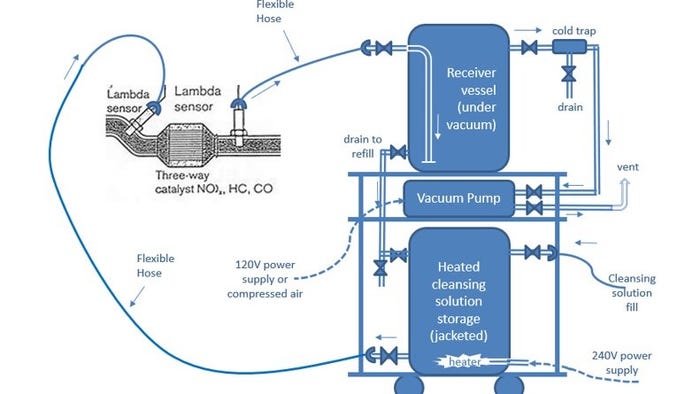Catalytic Converter ‘Cleanser’ Restores Emissions Systems, Saves Money
Tech company says there’s no need to replace failing catalytic converters if they can be effectively cleansed.

A Texas-based technology company is developing a system to chemically “cleanse” a catalytic converter back to near-new emission-control effectiveness, all at a fair price compared with replacing the expensive exhaust-treatment units.
ESL TEKnologies of Dallas is working hard to have its Catalytic Converter Cleanse (CCC) process market-ready by later this year. The process uses a patent-pending cleansing system on a skid that rolls under a vehicle up on a hydraulic lift.
The system pumps through the converter a proprietary mix of chemicals that dissolves and flushes out contaminants for about an hour (maybe less). After the treatment, the vehicle will be guaranteed to pass emissions for up to 12 months or 12,000 miles (19,312 km), the company says. The process could provide up to three years/36,000 miles (57,936 km) of new catalyst life if you opt for a special low-phosphorous oil the company also is developing. The oil dramatically reduces the rate of catalyst contamination.
ESL TEK will manufacture the skids, sell or lease them to shops and provide the cleansing solution, the low-phosphorous oil and the service guarantee.
ESL TEK President and CEO John T. “Cork” Jaeger says his company is in the process of finalizing the design and performance of the skid. He says the target price for the unit will be about $10,000, and they are working with equipment leasing companies to be able to offer flexible payment terms.

Diagram shows operation of ESL Catalytic Converter Cleanser.
“The next step on the technical side,” Jaeger explains, “is further field testing with the skid.”
The company is working closely with Alabama Law Enforcement Agency vehicle maintenance people to test the process on a vehicle that has accumulated 150,000 miles. Once cleansed, the catalyst was removed and sent to an independent testing facility to evaluate the level of cleanliness achieved.
“Then we'll cleanse another catalytic converter on a high-mileage vehicle that is displaying its emissions system warning light, signaling a potential catalytic converter problem,” Jaeger says.
Performing the cleansing service should extinguish the warning light, he says, and then the vehicle will be placed on a chassis dynamometer to accumulate mileage until the emissions system warning light is reactivated.
When CCC is fully ready, ESL TEK plans to demonstrate the unit to help sell this process. “You can talk about it, but when you actually see it in operation, you know you’re seeing something that has never been done before,” Jaeger says. “It’s pretty simple, and safe. Our cleansing solution is organic in nature, based on a concentrated version of lemon juice.”
Jaeger says they are aiming primarily at two markets: new-car dealers and the aftermarket.
New-car dealers can cleanse the converters on vehicles in their used-car fleets, making it possible to provide emissions guarantees. Those same used-car customers will need to return for service to obtain the required oil change needed to maintain the emissions warranties.
On the aftermarket side, with 32 states requiring emissions testing, emissions-test failures will trigger a good portion of the service opportunities, Jaeger says.
How much money a vehicle owner can save compared to having a new converter installed will vary depending on the vehicle’s age and the complexity of its emissions system, but Jaeger suggests it could be in the be hundreds of dollars to potentially $1,500 or more, depending on the vehicle.
“The key is how many catalytic converters the vehicle has and how they are mounted,” he says. “If we can price this service at around $450 for a single converter, customers can save as much as $1,000. For vehicles with two converters mounted side-by-side, with the cleansing price around $600, customers can save $1,500 on average and as much as $4,000 or more on some makes and models. At those levels of savings, the service almost sells itself.”
Jaeger says the company is considering a low-cost renewal for customers who choose the 12-month/12,000-mile option. He also believes ESL TEK’s low-phosphorous engine oil (once fully tested and licensed) will largely eliminate that objection. “The low-phosphorus oil will be offered as an alternative to a standard oil and will likely get three-year, 36,000-mile coverage,” he says.
The special oil has been tested over millions of state trooper miles in Alabama and is expected perform as well as other oils, Jaeger says. That testing also produced an unexpected bonus: about 2% better fuel economy in a majority of those vehicles whose operators had maintained reliable data.
Jaeger’s CCC and low-phosphorous engine oil co-inventor is Glenn Mazzamaro, who is vice president, Petroleum Additives at Vanderbilt Chemicals, and a key partner is David Sulfridge, a certified property and casualty underwriter (CPCU) and founder of DSL Associates, Inc., a consulting firm advising ESL TEK and other product innovators.
If this unique CCC process proves as effective and affordable as Jaeger and his ESL TEK team are confident it will, it promises to be a real game changer, especially in those states where emissions testing of used cars is required. Stay tuned.
About the Author(s)
You May Also Like
_(2).jpg?width=700&auto=webp&quality=80&disable=upscale)


